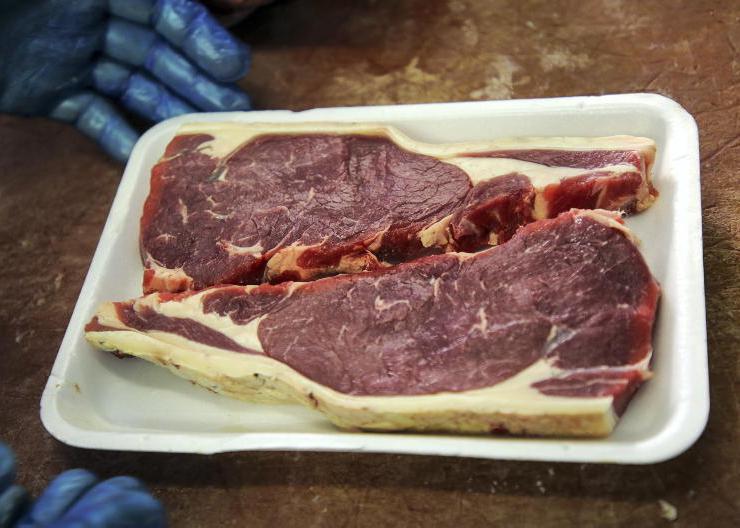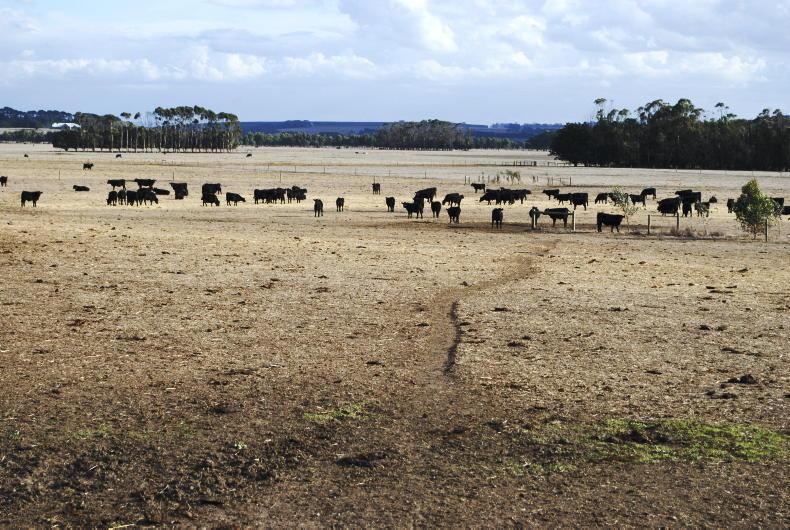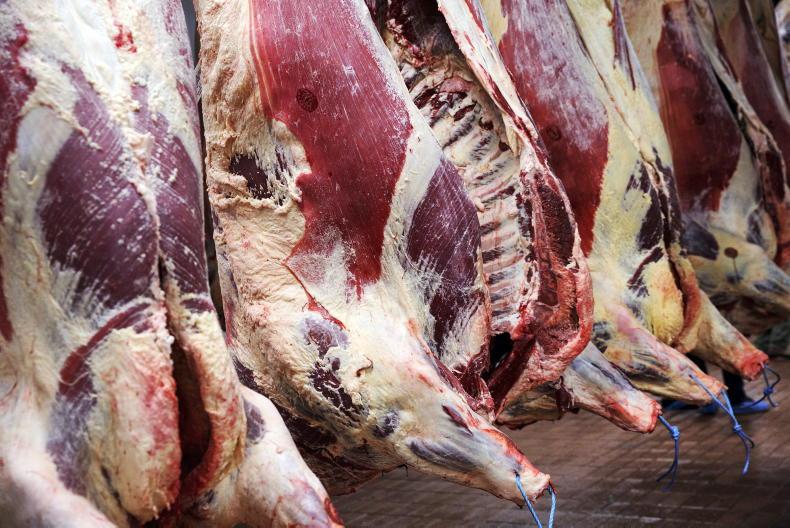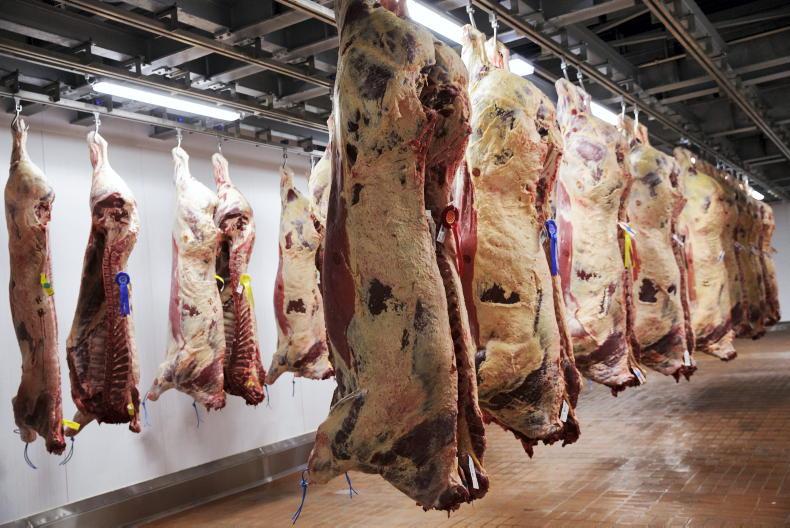The recent Bord Bia meat marketing seminar is one of the go-to events of the year when it comes to the meat industry.
Bord Bia does a great job summarising 2023 in terms of meat markets and dynamics and then looks to 2024 to see what it holds for the industry and its farmers.
Looking back at 2023 was a pretty positive experience with the only fly in the ointment being the banning of Irish beef being imported into China in November 2023, a ban that has been recently lifted, with Irish beef allowed access to the huge market once again in January 2024.
Volumes of beef exports were down in 2023 but the value of those exports actually went up in value.
Ireland exported €2.72bn worth of beef in 2023 accounting for 489,000 tonnes of carcase weight equivalents, a reduction of 3% on the 2022 figure.
The value of beef offal exported in 2023 came to €140m, an increase of 3% on 2022 while the value of value added beef exports came to €255m, an increase of 7% on the previous year.
Continental EU markets accounted for 47% of exports at €1.3bn, a reduction of 2% on the 2022 value.
Beef exports to the UK, by far Ireland’s largest and most important market accounted for 47% in 2023, an increase of 10% in value on the previous year.
International markets accounted for 5% of Irish beef exports or €128m in 2023, a reduction of 24% on the 2022 figure. This figure is a little concerning given the soundings from the EU on the resumption of the Mercosur trade deal talks and the United Kingdom’s ability to complete trade deals with third countries for their beef requirements, Australia being a good example.
Brexit remains a very real threat to the very existence of the Irish beef industry and more work will be needed to copper-fasten our share of the UK market based on our production and food safety standards.
More work will also be required to diversify our markets on the international stage.
While regaining access to the Chinese market is obviously a positive story, there are some within the industry who would say that we have missed the boat in terms of building long-term relationships with China.
In any case, it’s a long-term play with a timescale of a blip-free five to 10 years in the market before any real progress is made.
Outside of the UK market, France is Ireland’s most important market for beef coming in at €346m in value in 2023, an increase of 2% on 2022.
The Belgian market was up 8% to €8m in 2023. The Spanish, Swedish and Dutch markets were all down in value when compared to 2022 exports.
Figure 2 outlines Irish cattle supplies over the last seven years, including a projected figure for the 2024 kill. The Irish kill was down 2% or 38,702 head in 2023 with a 4% or 45,769 head reduction in the prime cattle kill.
The cow kill increased by 4,861 head, or 1% in 2023. Big weekly kills in both autumn and spring 2023 on the back of huge demand from the UK have helped the positive start to the 2024 trade with beef prices continuing to creep upwards in recent weeks.
According to Bord Bia, the 2024 kill looks like it will contract by a further 30,000 to 40,000 head in 2024, putting further pressure on factory supplies.
In terms of price, the Irish beef price was very much bottom of the EU class in autumn 2023 with the Irish beef price lagging by as much as 40c/kg when compared to EU average prices and over €1/kg when compared with the UK market.
The average Irish R3 bullock price came in at €4.96/kg (+4%)in 2023, the UK price averaged €5.51/kg (+7.5%) while the EU average came in at €4.96/kg in 2023.
Last year was very strong for live exports with a total of 115,000 weanlings, store and adult cattle exported in 2023.
There is growing demand for Irish cattle in response to disease issues in France and Spain, while tighter cattle supplies across eastern Europe is driving demand.
Strong interest
There is also strong interest from North Africa and a number of shipments have already departed for these markets since the beginning of the new year.
UK beef production is expected to decline in 2024 by 0.5%. Retail sales in the UK saw a decline of 1.7% in 2023 coupled with a 10.8% increase in price.
Food service saw a strong 2023 for sales with food service sales up 5.6% in 2023.
The only issue of concern for 2024 is the strong competition from pork and poultry in terms of price to the consumer.
EU beef production will see a 3.6% reduction in 2024. Imports of beef into the EU actually declined in 2023 by 3% but are expected to increase in 2024. That 5.3% increase in EU imports presents a threat to the Irish industry, given its high dependency on the lucrative EU market.
Carcase weights continue to drop and the details are outlined in Figure 1. Young bulls saw the largest decrease in terms of carcase weight in 2023, a reduction of 10kg followed by cows reducing by 8kg.
Bullocks reduced by 4kg and heifers reduced by 5kg with young bulls being the only cattle seeing an increase in 2023 of 8kg.
One point of concern that has arisen is the rise in the number of animals grading at O and P in the last number of years.
Fat scores are also decreasing with a rise of 8% of fat score two bullocks being killed between 2021 and 2023. Last year saw the highest ever proportion of P grade cows killed at 65% of the total cow kill.
Calf registrations
In terms of calf registrations a massive fall has been seen in the number of suckler calves being registered in 2023, a reduction of 60,000 head.
Dairy births saw a 1.1% increase in 2023
This presents real challenges for the Irish beef industry with over 63% of the national kill originating from the dairy herd.
Dairy births saw a 1.1% increase, or 18,000 head increase, in 2023. Delving a little deeper into dairy births we see that sexed semen is starting to have a large effect on the birth of dairy bull calves, down 17% or 69,209 head in 2023. Beef-sired calves increased by 58,825 head in 2023 or 4%.
The science of shopper insights
Bod Bia has some really interesting information in relation to shopping habits and what makes shoppers purchase beef on a monthly basis.
Fionnuala Fahy from Bord Bia’s Thinking House division presented information on its newly established meat shopper monitor which tracks purchasing habits from 500 shoppers on a monthly basis in seven different European markets important for Irish meat sales.
They are Ireland, Germany, France, Italy, the United Kingdom, Belgium and Sweden.
The results from quarter four show that inflation continues to hit people’s spending but there is slightly more optimism compared to this time last year.
One in five Germans felt they would be better off in 2024, while 24% of UK shoppers felt 2024 would be a better year for their finances. The home-cooked meal is now firmly entrenched in households with 47% of people cooking from scratch more than they were.
Shoppers are also constantly looking for something easy to cook
Shoppers are also trying to minimise food waste through meal prepping.
Shoppers are also looking to cooking approaches to make their meals go further and reduce expenditure.
Half of Irish consumers are buying cheaper cuts of meat to reduce household expenditure, while 72% of consumers are looking to make meals go further when they cook.
Shoppers are also constantly looking for something easy to cook. Social media is also playing a role in shopping decisions with 29% of consumers doing more browsing on social media for cheaper meal ideas.
The weekend shopper is an important one when it comes to meat sales.
Three-quarters of Irish consumers felt that beef is a protein that is worth paying more for, while 89% of UK consumers saw beef as a weekend treat.
Concern
One point of concern is that 70% of UK shoppers have noticed that some food packages contained a smaller amount of the actual product than suggested by the size of the packaging, known as slack filling.
Meanwhile, 84% of Italian consumers want to know more about how their beef that they purchase is produced.
Consumers are also stepping back a little from processed foods and beef ranks high in terms of least amount of processing in consumers eyes.
25c/kg Hereford bonus confirmed for 2024
The Irish Hereford Prime beef producer group has announced a higher bonus of up to 25c/kg for all Hereford cattle pre-booked for this spring and early summer period.
The increased bonus will be available at all ABP Group and Kepak Group sites throughout Ireland for both qualifying steers and heifers.
Spring/summer 2024 off-season bonus will be available from 18 March to 17 May 2024 (weeks 12 to 20). Hereford animals booked in with the producer group by 23 February 2024 will be eligible for the higher off-season bonus. According to Niall O’Mahony, chair of Irish Hereford Prime, “rewarding farmers who produce the right type of cattle at the right time is crucial for both our members’ viability and that of our brand in the marketplace.
“The increasing demands for product with high sustainability credentials puts our beef in a very good place due to the Hereford breeds natural early maturing and easy fleshing abilities.
“Finishing Hereford cattle at a younger age is clearly what the market requires, and the Hereford breed traits excel at this”.
The recent Bord Bia meat marketing seminar is one of the go-to events of the year when it comes to the meat industry.
Bord Bia does a great job summarising 2023 in terms of meat markets and dynamics and then looks to 2024 to see what it holds for the industry and its farmers.
Looking back at 2023 was a pretty positive experience with the only fly in the ointment being the banning of Irish beef being imported into China in November 2023, a ban that has been recently lifted, with Irish beef allowed access to the huge market once again in January 2024.
Volumes of beef exports were down in 2023 but the value of those exports actually went up in value.
Ireland exported €2.72bn worth of beef in 2023 accounting for 489,000 tonnes of carcase weight equivalents, a reduction of 3% on the 2022 figure.
The value of beef offal exported in 2023 came to €140m, an increase of 3% on 2022 while the value of value added beef exports came to €255m, an increase of 7% on the previous year.
Continental EU markets accounted for 47% of exports at €1.3bn, a reduction of 2% on the 2022 value.
Beef exports to the UK, by far Ireland’s largest and most important market accounted for 47% in 2023, an increase of 10% in value on the previous year.
International markets accounted for 5% of Irish beef exports or €128m in 2023, a reduction of 24% on the 2022 figure. This figure is a little concerning given the soundings from the EU on the resumption of the Mercosur trade deal talks and the United Kingdom’s ability to complete trade deals with third countries for their beef requirements, Australia being a good example.
Brexit remains a very real threat to the very existence of the Irish beef industry and more work will be needed to copper-fasten our share of the UK market based on our production and food safety standards.
More work will also be required to diversify our markets on the international stage.
While regaining access to the Chinese market is obviously a positive story, there are some within the industry who would say that we have missed the boat in terms of building long-term relationships with China.
In any case, it’s a long-term play with a timescale of a blip-free five to 10 years in the market before any real progress is made.
Outside of the UK market, France is Ireland’s most important market for beef coming in at €346m in value in 2023, an increase of 2% on 2022.
The Belgian market was up 8% to €8m in 2023. The Spanish, Swedish and Dutch markets were all down in value when compared to 2022 exports.
Figure 2 outlines Irish cattle supplies over the last seven years, including a projected figure for the 2024 kill. The Irish kill was down 2% or 38,702 head in 2023 with a 4% or 45,769 head reduction in the prime cattle kill.
The cow kill increased by 4,861 head, or 1% in 2023. Big weekly kills in both autumn and spring 2023 on the back of huge demand from the UK have helped the positive start to the 2024 trade with beef prices continuing to creep upwards in recent weeks.
According to Bord Bia, the 2024 kill looks like it will contract by a further 30,000 to 40,000 head in 2024, putting further pressure on factory supplies.
In terms of price, the Irish beef price was very much bottom of the EU class in autumn 2023 with the Irish beef price lagging by as much as 40c/kg when compared to EU average prices and over €1/kg when compared with the UK market.
The average Irish R3 bullock price came in at €4.96/kg (+4%)in 2023, the UK price averaged €5.51/kg (+7.5%) while the EU average came in at €4.96/kg in 2023.
Last year was very strong for live exports with a total of 115,000 weanlings, store and adult cattle exported in 2023.
There is growing demand for Irish cattle in response to disease issues in France and Spain, while tighter cattle supplies across eastern Europe is driving demand.
Strong interest
There is also strong interest from North Africa and a number of shipments have already departed for these markets since the beginning of the new year.
UK beef production is expected to decline in 2024 by 0.5%. Retail sales in the UK saw a decline of 1.7% in 2023 coupled with a 10.8% increase in price.
Food service saw a strong 2023 for sales with food service sales up 5.6% in 2023.
The only issue of concern for 2024 is the strong competition from pork and poultry in terms of price to the consumer.
EU beef production will see a 3.6% reduction in 2024. Imports of beef into the EU actually declined in 2023 by 3% but are expected to increase in 2024. That 5.3% increase in EU imports presents a threat to the Irish industry, given its high dependency on the lucrative EU market.
Carcase weights continue to drop and the details are outlined in Figure 1. Young bulls saw the largest decrease in terms of carcase weight in 2023, a reduction of 10kg followed by cows reducing by 8kg.
Bullocks reduced by 4kg and heifers reduced by 5kg with young bulls being the only cattle seeing an increase in 2023 of 8kg.
One point of concern that has arisen is the rise in the number of animals grading at O and P in the last number of years.
Fat scores are also decreasing with a rise of 8% of fat score two bullocks being killed between 2021 and 2023. Last year saw the highest ever proportion of P grade cows killed at 65% of the total cow kill.
Calf registrations
In terms of calf registrations a massive fall has been seen in the number of suckler calves being registered in 2023, a reduction of 60,000 head.
Dairy births saw a 1.1% increase in 2023
This presents real challenges for the Irish beef industry with over 63% of the national kill originating from the dairy herd.
Dairy births saw a 1.1% increase, or 18,000 head increase, in 2023. Delving a little deeper into dairy births we see that sexed semen is starting to have a large effect on the birth of dairy bull calves, down 17% or 69,209 head in 2023. Beef-sired calves increased by 58,825 head in 2023 or 4%.
The science of shopper insights
Bod Bia has some really interesting information in relation to shopping habits and what makes shoppers purchase beef on a monthly basis.
Fionnuala Fahy from Bord Bia’s Thinking House division presented information on its newly established meat shopper monitor which tracks purchasing habits from 500 shoppers on a monthly basis in seven different European markets important for Irish meat sales.
They are Ireland, Germany, France, Italy, the United Kingdom, Belgium and Sweden.
The results from quarter four show that inflation continues to hit people’s spending but there is slightly more optimism compared to this time last year.
One in five Germans felt they would be better off in 2024, while 24% of UK shoppers felt 2024 would be a better year for their finances. The home-cooked meal is now firmly entrenched in households with 47% of people cooking from scratch more than they were.
Shoppers are also constantly looking for something easy to cook
Shoppers are also trying to minimise food waste through meal prepping.
Shoppers are also looking to cooking approaches to make their meals go further and reduce expenditure.
Half of Irish consumers are buying cheaper cuts of meat to reduce household expenditure, while 72% of consumers are looking to make meals go further when they cook.
Shoppers are also constantly looking for something easy to cook. Social media is also playing a role in shopping decisions with 29% of consumers doing more browsing on social media for cheaper meal ideas.
The weekend shopper is an important one when it comes to meat sales.
Three-quarters of Irish consumers felt that beef is a protein that is worth paying more for, while 89% of UK consumers saw beef as a weekend treat.
Concern
One point of concern is that 70% of UK shoppers have noticed that some food packages contained a smaller amount of the actual product than suggested by the size of the packaging, known as slack filling.
Meanwhile, 84% of Italian consumers want to know more about how their beef that they purchase is produced.
Consumers are also stepping back a little from processed foods and beef ranks high in terms of least amount of processing in consumers eyes.
25c/kg Hereford bonus confirmed for 2024
The Irish Hereford Prime beef producer group has announced a higher bonus of up to 25c/kg for all Hereford cattle pre-booked for this spring and early summer period.
The increased bonus will be available at all ABP Group and Kepak Group sites throughout Ireland for both qualifying steers and heifers.
Spring/summer 2024 off-season bonus will be available from 18 March to 17 May 2024 (weeks 12 to 20). Hereford animals booked in with the producer group by 23 February 2024 will be eligible for the higher off-season bonus. According to Niall O’Mahony, chair of Irish Hereford Prime, “rewarding farmers who produce the right type of cattle at the right time is crucial for both our members’ viability and that of our brand in the marketplace.
“The increasing demands for product with high sustainability credentials puts our beef in a very good place due to the Hereford breeds natural early maturing and easy fleshing abilities.
“Finishing Hereford cattle at a younger age is clearly what the market requires, and the Hereford breed traits excel at this”.









SHARING OPTIONS